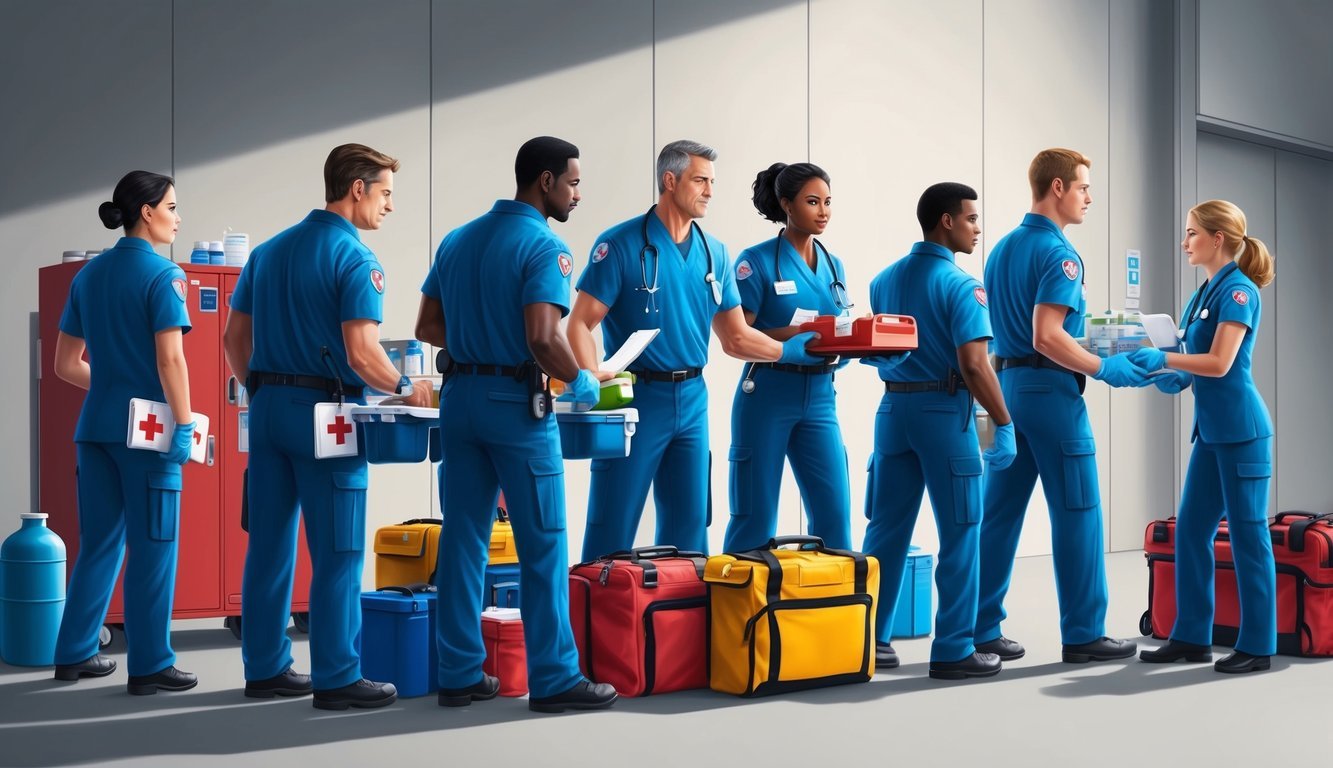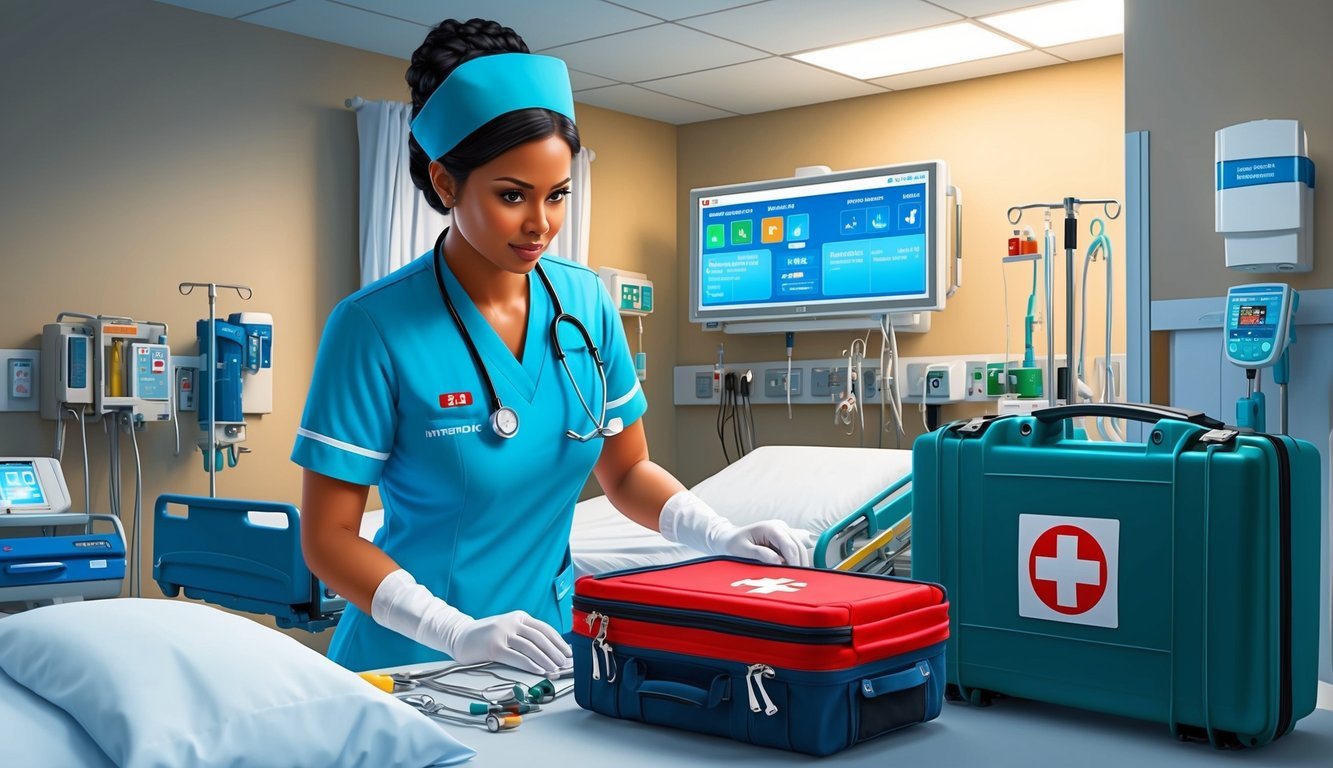Rapid Response Team (RRT) nurses play a crucial role in providing immediate care during medical emergencies within a hospital. These specialized nurses are trained to act quickly to assess and stabilize patients who show signs of a decline in their health. By bridging the gap between regular nursing care and critical intervention, RRT nurses help to enhance patient safety and improve outcomes in urgent situations.
In hospitals, the presence of an RRT nurse can make a significant difference when patients experience sudden changes in their conditions.
With the right skills and training, these nurses not only respond to crises but also educate other staff members about recognizing early warning signs.
As you learn about the responsibilities and impact of RRT nurses, you will gain a better understanding of their vital contribution to effective healthcare.
Key Takeaways
- RRT nurses are essential for responding to medical emergencies in hospitals.
- Their quick actions help improve patient safety and outcomes.
- Ongoing training is important to keep RRT nurses prepared for various challenges.
Understanding Rapid Response Teams

Rapid Response Teams (RRTs) play a crucial role in enhancing patient safety and improving healthcare outcomes.
They aim to quickly assess and manage critically ill patients.
RRTs consist of various professionals who collaborate to provide immediate care.
Composition of Rapid Response Teams
A Rapid Response Team typically includes a combination of healthcare providers such as nurses, physicians, and respiratory therapists.
| Role | Responsibilities |
|---|---|
| Nurse | Initial assessment and patient monitoring |
| Physician | Diagnosis and treatment initiation |
| Respiratory Therapist | Airway management and respiratory support |
Team members must have a strong understanding of each other’s roles to function effectively.
This multidisciplinary approach ensures that patient needs are met swiftly and efficiently.
Rapid Response Systems
Rapid Response Systems (RRS) are structured protocols that allow for rapid activation of medical teams during emergencies.
You may recognize these as systems designed to intervene when a patient’s condition worsens.
Key components of an RRS include:
- Activation criteria: Specific signs that indicate the need for RRT intervention
- Communication protocols: Clear procedures for staff to alert the RRT
- Follow-up strategies: Processes to evaluate the effectiveness of the team’s response
These systems are vital for improving patient outcomes, reducing delays in care, and preventing further deterioration.
Evolution of Rapid Response Teams in Clinical Settings
Rapid Response Teams have evolved significantly in healthcare settings.
Initially created to address high rates of in-hospital complications, RRTs have expanded their roles.
You can see this evolution through:
- Increased training: Ongoing education for RRT members improves interventions.
- Broader scope: Many teams now handle more than just emergencies, offering preventive care as well.
- Data tracking: Hospitals use metrics to evaluate team effectiveness and patient outcomes.
As healthcare continues to improve, RRTs will adapt to new challenges, striving to ensure that patient care remains at the forefront.
Roles and Responsibilities of RRT Nurses

RRT nurses play a crucial role in managing clinical emergencies.
Their work involves prompt assessment, effective communication, and continuous monitoring of patients at risk of deterioration.
Clinical Assessment and Intervention
As an RRT nurse, your primary duty involves assessing patients who show signs of clinical deterioration.
You quickly evaluate vital signs, lab results, and other indicators to determine the level of urgency.
Once the assessment is complete, you initiate appropriate interventions.
This may involve administering medications, providing respiratory support, or initiating advanced life support if necessary.
Your ability to make swift, informed decisions can significantly impact the outcome for the patient in crisis.
You often collaborate with other healthcare professionals, ensuring that the interventions align with the patient’s overall treatment plan.
Your expertise in critical situations helps to stabilize patients and prevent further complications.
Communication and Team Coordination
Effective communication is vital in your role as a rapid response nurse.
You must relay critical information to the care team, including the patient’s status and any immediate needs.
This ensures everyone involved understands the situation and can act accordingly.
You coordinate with doctors, bedside nurses, and other team members during emergencies.
Your ability to be clear and concise minimizes confusion and helps the team act with urgency and precision.
Additionally, you educate other nurses about potential risks and how to recognize when to call for assistance.
By fostering a culture of open communication, you enhance patient care and safety across the entire unit.
Continuous Monitoring and Follow-Up
After an intervention, continuous monitoring of the patient is essential.
You regularly check vital signs and assess the effectiveness of treatments to ensure the patient’s condition is stable.
Your role also involves documenting the patient’s response to interventions and any changes in their condition.
This information is crucial for follow-up care and helps inform decisions about long-term treatment options.
Moreover, you follow up with the healthcare team to discuss the patient’s progress and any necessary adjustments to the care plan.
This ongoing involvement helps ensure that patients receive comprehensive, coordinated care throughout their treatment journey.
Impact of Rapid Response Teams on Patient Safety
Rapid Response Teams (RRTs) play a crucial role in enhancing patient safety within hospitals.
They focus on early intervention during medical emergencies.
This proactive approach can lead to significant improvements in clinical outcomes, including reduced rates of cardiac arrest and mortality.
Reduction in Cardiac Arrests and Mortality
The implementation of RRTs has shown a clear reduction in cardiac arrests.
Nurses and other team members are trained to recognize early signs of deterioration.
This enables timely interventions that can prevent the progression to cardiac arrest.
Research indicates that hospitals using RRTs experience fewer cardiac arrests compared to those without them.
This is largely due to the immediate response when vital signs indicate distress.
Quick action can stabilize patients and lead to better survival rates.
Improvement in Hospital Mortality Rates
Hospital mortality rates can significantly decrease with effective RRTs in place.
Studies reveal that hospitals using these teams report fewer deaths, particularly in acutely ill patients.
Early identification and treatment of complications help improve patient outcomes.
With the support of RRTs, there is better communication and collaboration among healthcare staff.
This teamwork allows for swift adjustments to patient care plans, which are essential during critical moments.
The combined efforts of the RRT can lead to an environment where patient safety is prioritized.
Efficiency in Failure to Rescue Situations
RRTs excel in failure to rescue situations, where a patient’s condition worsens unexpectedly.
These teams provide an organized system for escalating care.
When patients show early signs of decline, the RRT can be activated quickly.
This approach mitigates the risks associated with delayed interventions.
Studies suggest that RRTs significantly decrease failure to rescue events.
Having a structured response in place can lead to better outcomes and improved patient safety.
Training and Continuing Education for RRT Nurses

Training and continuing education are crucial for RRT nurses to develop the necessary competencies in critical care.
These programs ensure that you stay current with best practices, technology, and patient care standards.
You will cultivate essential skills, enabling you to handle emergencies effectively and improve patient outcomes.
Core Competencies and Skills
As a rapid response team (RRT) nurse, you must master a range of core competencies.
These include critical thinking, communication, and clinical skills.
Key skills include:
- Assessment: Quickly evaluating patient conditions.
- Collaboration: Working with interdisciplinary teams to address emergencies.
- Crisis management: Leading efforts to stabilize patients.
Training often involves simulated scenarios and hands-on practice, allowing you to apply skills in real-time.
This experiential learning is vital for your confidence and effectiveness in high-pressure situations.
For more structured competency training, consider resources such as the AARC Continuing Respiratory Care Education.
Advancements in Critical Care Training
Staying updated with advancements in critical care is essential.
Programs that focus on new technologies and treatment protocols enhance your ability to provide high-quality care.
This includes training on the latest equipment and procedures used in emergency settings.
You may also participate in workshops and certifications focused on:
- Advanced Cardiovascular Life Support (ACLS)
- Pediatric Advanced Life Support (PALS)
- Critical Care Nursing Certification (CCRN)
By attending these programs, you improve not only your skills but also your value in the job market.
Many positions in critical care offer competitive salaries, which can reach around $70,000 or more annually for experienced RRT nurses.
Career Progression and Specialization
Career progression for RRT nurses can be dynamic.
With additional training and education, you can specialize in areas such as:
- Pediatric care: Focusing on critical interventions for children.
- Cardiology: Managing heart-related emergencies.
- Trauma: Responding to life-threatening injuries.
Pursuing certifications in these fields can enhance your qualifications and open new job opportunities.
Many RRT nurses find that specialized training not only increases their salary potential but also allows for more fulfilling roles in healthcare.
Engaging in continuing education programs will keep your skills sharp and your knowledge current.
Explore options for specialization through programs like the Asthma Educator Institute for those interested in respiratory conditions.
Challenges and Considerations in Rapid Response Nursing

Rapid response nurses face unique challenges that require swift solutions.
Addressing barriers to activation, fostering teamwork across disciplines, and ensuring thorough documentation are crucial for effective patient care.
Each consideration plays a key role in preventing adverse clinical outcomes and enhancing the RRT’s overall effectiveness.
Overcoming Barriers to RRT Activation
You may encounter several barriers that hinder RRT activation.
Common issues include unclear protocols, inadequate training, or a lack of confidence among staff.
To improve activation rates, consider the following strategies:
- Clear Guidelines: Develop and distribute clear protocols on when to activate RRT.
- Regular Training: Conduct frequent training sessions to boost staff confidence.
- Encourage Communication: Foster an environment where staff feel comfortable reporting concerns.
By addressing these barriers, you can help ensure timely interventions, reducing the risk of adverse clinical outcomes.
Navigating Interdisciplinary Dynamics
Working within interdisciplinary teams can be challenging.
Differences in communication styles and professional priorities may lead to misunderstandings.
To enhance collaboration:
- Establish Roles: Clearly define roles for each team member, including responsibilities during an RRT call.
- Regular Meetings: Hold routine interdisciplinary meetings to discuss case studies and review RRT activations.
- Feedback Loops: Implement a system for providing constructive feedback, promoting a culture of continuous improvement.
By strengthening teamwork, you can improve patient triage and clinical outcomes during critical situations.
Ensuring Quality Documentation and Accountability
Accurate documentation is vital in maintaining accountability within RRT functions.
You must create clear records to ensure all actions taken during an RRT activation are noted and easily accessible.
Consider these documentation practices:
- Standardized Templates: Use consistent documentation templates to streamline the process.
- Timely Updates: Ensure documentation occurs immediately following interventions to maintain accuracy.
- Audit Regulations: Regularly audit documentation quality to identify areas for improvement.
Consistent and thorough documentation not only supports interdisciplinary communication but also protects against legal issues that may arise from adverse clinical outcomes.
Frequently Asked Questions
This section addresses common questions about rapid response nurses.
You will find information on certification, differences from emergency room nurses, responsibilities, salary, training requirements, and how rapid response teams work with other departments.
How does one become certified as a rapid response nurse?
To become certified as a rapid response nurse, you typically need to be a registered nurse (RN) with clinical experience in critical care.
Many certification programs require you to complete specific courses in patient assessment, emergency response, and stabilization techniques.
After that, you can take a certification exam offered by organizations like the American Association of Critical-Care Nurses.
What differentiates a rapid response nurse from an emergency room nurse?
Rapid response nurses focus on assessing and stabilizing patients in acute distress throughout the hospital.
They act quickly to prevent complications and may work outside of the emergency room.
Emergency room nurses, on the other hand, primarily provide care to patients arriving at the hospital with urgent medical needs.
What are the primary responsibilities of a nurse on a Rapid Response Team?
A nurse on a Rapid Response Team (RRT) has several key responsibilities, including:
- Assessing patients in emergencies
- Providing initial treatment and intervention
- Collaborating with physicians and other healthcare staff
- Educating other nurses about patient care strategies
What is the average salary for a rapid response nurse in different locations?
The average salary for rapid response nurses can vary by location.
Below is a table showing the estimated annual salaries in different regions:
| Location | Average Salary |
|---|---|
| National Average | $86,737 |
| New York, NY | $95,000 |
| California | $90,000 |
| Texas | $80,000 |
Salary figures can change based on experience and workplace.
What type of training or education is required to become a rapid response nurse?
To become a rapid response nurse, you generally need a Bachelor of Science in Nursing (BSN) degree.
Completion of critical care nursing courses or certifications enhances your knowledge and skills.
Hands-on training through clinical rotations and experience in medical-surgical or ICU settings is also important.
How do rapid response teams integrate with other hospital departments?
Rapid response teams work closely with other hospital departments to ensure seamless patient care.
They collaborate with:
- Intensive Care Units (ICUs)
- Emergency Departments (EDs)
- Respiratory Therapy
Effective communication among these areas helps ensure timely intervention and improves patient outcomes.

